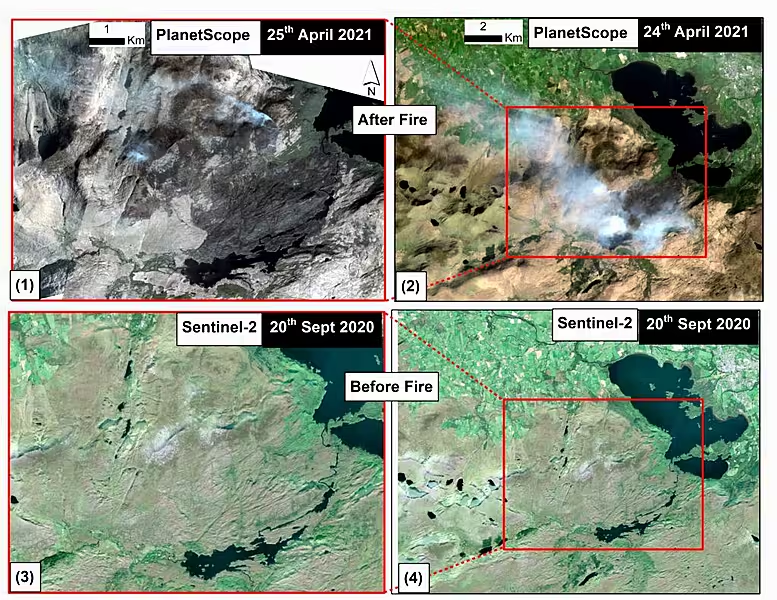
The devastation caused by a three-day fire which raged through Killarney National Park over the weekend has been revealed in new satellite images.
The images from the Irish Centre for High-End Computing (ICHEC) show the estimated 2,500 to 3,000 hectares of the park affected by the fire, out of a total 5,000.
The ICHEC said the images show the “devastating effect” of the fire on the special area of conservation, home to 26 protected species and 14 protected habitats under EU directives.
The ICHEC map below shows the affected area lies at the heart of the special area of conservation, with the loss of these unique habitats to have “an untold impact on local and national biodiversity.”

Satellite images then show the extent of the destruction of the forested area. Below, images from the PlanetScope satellite display the damaged area on the days the fire was active.
These images from April 24th and 25th, shown in the top panels of the photos below, illustrate how fast the fire was spreading in the National Park and the changing extent of the burnt area from day to day.
Other images from the European Space Agency (ESA)’s Sentinel-2 satellite, displayed in the bottom panel of the photos below, show the area before the fire for comparison.

Top panels: PlanetScope scenes from 24th and 25th of April after the fire in Killarney National Park. Bottom panels: Sentinel-2 image acquired before the fire in September 2020 for comparison.
The ICHEC said the PlanetScope images were acquired during the late morning hours and shadows of the hills are visible, but the picture on the left (1) “clearly shows the charred landscape following the fire” and (2) shows smoke from active fires on the previous day.
These images are in contrast to what the landscape looked like in September 2020 (3 and 4 from Sentinel-2).
Below, further images show that the predominant land use type in the affected area are forest, semi natural lands, wetlands and small patches of agricultural lands on the southern side.
The aerial views below show that the forested and semi-natural areas (green outlines) are mostly affected, followed by the areas designated as natural wetland.

Corine land cover data draped over PlanetScope images. Agricultural and forested areas are shown in purple and green colors respectively.
Earth Observation Programme Manager at ICHEC, Jenny Hannafin, said the images demonstrated the potential to advance use of Earth Observation (EO) data for monitoring natural and man-made environmental change.
“ICHEC is currently involved in a number of European Space Agency projects to advance the development of methods, tools and applications for AI4EO [European Artificial intelligence for Earth Observation], as well as deploying AI in space on-board remote sensing satellites.”
The fire in the national park was brought under control on Tuesday afternoon, as five helicopters doused water on the final flames.
Questions remain about why the county's emergency plan was not activated on Saturday and why air support was limited.
Killarney National Park is a UNESCO World Biosphere site, and the area affected by the recent fire is both a special area of conservation and a special protected area under national law.













